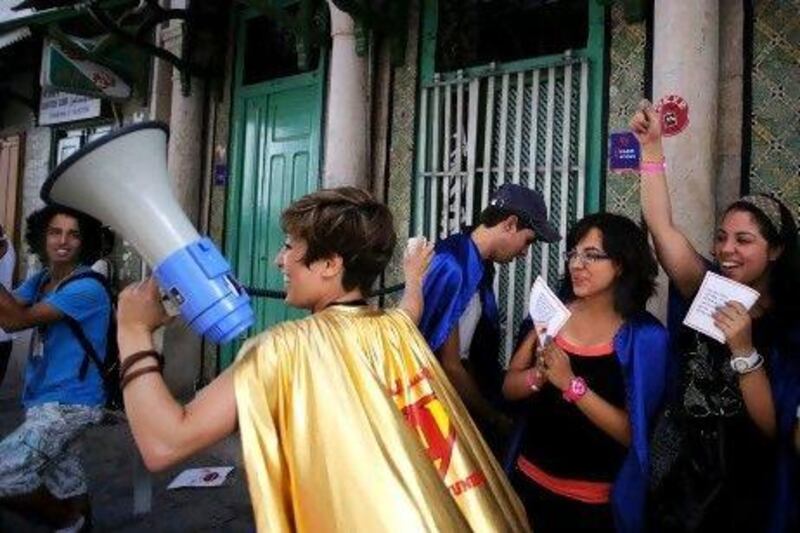TUNIS // There were curious sights in the ancient medina of Tunis last week. Under its black-and-white Ottoman arches people in Superman capes pranced, while dancers and actors improvised in narrow streets, past turquoise doors and trailing bougainvillaea.
Couples reclining in rooftop cabins admired the view of the Al Zaytuna mosque, long a centre of Islamic learning.
The occasion was the third edition of Dream City, a roughly biennial art festival based in the mansions and traditional workshops of the oldest part of the Tunisian capital and, this week, in the city of Sfax, 273 kilometres south.
Showcasing the work of about 100 artists, the project, funded by international cultural groups, aims to do many things - present art to citizens, bring people face-to-face with their history and tempt a rather elite cultural crowd into a neighbourhood where rich and poor, religious and secular, people live alongside one another.
Lofty aims, and ones that have been in place since the event was first created in 2007. But after last year's overthrow of the president, the festival's directors say that where they once faced autocratic oppression they now have to consider the "dictatorship of the people", as hardline Islamists take violent exception to much contemporary art. Since Dream City's last incarnation - in 2010 - the president, Zine Al Abidine Ben Ali, fell, and a chaotic period ensued for the creative world. A flowering of freedom was tempered by a surge in religious extremists who condemn some art.
Over the summer, galleries and concerts were subject to violent protests. The government, led by moderate Islamists Ennahda, wavers between arresting men who target artists, and calling for firm anti-blasphemy legislation that could criminalise "offensive" art.
"Under the old censorship and oppression - it was conspicuous; we could locate it; it was clear for us," said Sofiane Ouissi, who along with his sister, Selma, is the creative director of the festival.
"But now, since it was displaced, it has come into the public space, you never know where dictatorship is going to emerge." Mr Ouissi's hair breaks in chestnut waves over his shoulders, and he spoke mellifluous French during the interview in the house where the festival was headquartered for its five-day span.
In some ways he embodies the values that Ben Ali and his predecessor, Habib Bourguiba, insisted were the spirit of Tunisia: he is tolerant, secular, educated. And when he talks about his art collective's means of tiptoeing through the strictures of the old police state (finding indirect, subtle ways to express themselves, a careful self-censorship so that no explicit censorship was ever required), he outlines the way of life for millions of Tunisians for decades.
But today voices insisting that this is not, and never was, the Tunisian way have grown louder. Religious leaders who, rather than moderating their message under Ben Ali, spent time in jail have been released and grown in popularity. What can, on a good day, seem like a healthy political debate about the identity of the changed nation turns into something far nastier in dark moments such as September 14, when four people died in riots outside the American embassy over an anti-Muslim film trailer.
Dream City does not appeal to everyone. In one of the medina's narrow streets, Mohammed Arabi Bushnek, 32, was reading a prayer book while attending his stall selling scarves. Mr Bushnek, who was born in the medina, said he admired the area's "Islamic and Arabic spirit" and welcomed the clusters of first-time visitors consulting the festival's maps. But said that drawings, depictions of people and all theatre and dance were wrong, religiously speaking. While he would never condone violence, he looks forward to a day when religious police prevent such events from taking place. Also, business was not great and he would have liked it if the art lovers bought more scarves.
Many who appreciate art also agree to a degree with the idea that Tunisian identity is Islamic, and that there should be limits on freedom of expression. Selma, a 20-year-old architecture student, is by most standards elite and liberal. Touring exhibits with her stylish, unveiled girlfriends, she had sneaked into the medina because in the well-to-do suburb in which she lives, people consider the area dangerous.
But she said frankly, "I think there are some subjects that are better to avoid, and religion is a quite tricky subject …. When we talk about black people, it's racism, when we talk about gay people, it's homophobia but when we talk about religion, it's freedom of speech?"
It is a charged atmosphere, and the festival, while not taking big risks with its subject matter, has taken an explicitly political tone. As the festival blurb goes: "What a paradox to assert today that it is even more difficult than yesterday to be an artist in Tunisia! After a popular uprising which could (should) have generated more gratitude towards those who prompt public debate and disrupt the codes to arouse questions, we would have liked to declare the opposite."
Sofiane insists that while the language may have changed and the tone become more strident, the political dimension of art has long been there in the Arab world, and will be inevitable for some time to come. "I think this is the reality. Politics is omnipresent in the Arab world," he said. "Art has always dealt with politics and artists have always been activists against their will - because it's something you can't escape."





